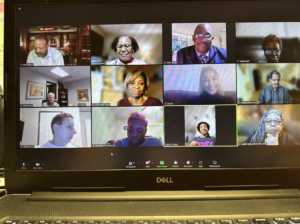Toastmasters helps build confidence and instill good habits
By Lee Hurley
Photos by Brit Huckabay
Motivational speaker Brain Tracy said, “Communication is like riding a bicycle or typing. If you’re willing to work at it, you can rapidly improve the quality of every part of your life.” Nowhere is that more obvious than in a Toastmaster’s Zoom meeting on a Monday evening in January. I spent an hour watching members practice their speaking skills with panache and aplomb. The focus was on helping each other communicate in an educational and encouraging manner. As I listened in on this evening, I silently thanked my lucky stars that no one was calling on me. After all, most of us are quite confident when communicating one on one. But ask us to stand up in front of others and that’s when the panic sets in.
Toastmasters to the rescue!!
Toastmasters International is a nonprofit educational organization that teaches public speaking and leadership skills. The organization has been around for 98 years with more than 14,000 clubs in 144 countries. At its core, Toastmasters was created to help improve public speaking. Yet it’s more than that. It’s about thinking on your feet, conjuring up the right things to say at the right time. It’s about learning to organize your thoughts and ideas and relaying those thoughts in a methodical, relaxed way that helps connect ideas and concepts with others. It’s about building trust and friendship. Members help each other conquer their fear though kindness, encouragement, and gentle feedback.
Wanda Spillers started the Circle of Champions Toastmasters chapter, which includes Alabaster, in April 2009. Spillers learned about Toastmasters International at a United States Air Force officer leadership training course in Montgomery, where she was asked to speak to the group, and in her own words, “I was uncomfortable, and it showed.” Her instructor suggested she join a Toastmasters group, and not only did she join one, she started one too—now the Circle of Champions Toastmasters club has been around for 14 years. While Spiller has held a variety of leadership roles since founding the organization, Qiana Shaw is the current president, leading the club’s 17 members and counting.
While most meetings are in person, lately some have been held via Zoom, which offers its own set of challenges and opportunities to grow. Speaking within a group on a video chat can be awkward. Yet applying the Toastmaster’s rules of good communication and common sense, Zoom becomes just another channel to be clearly understood. Instead of others talking over each other, the meetings are organized, with specific roles for different members of the group.
![]()

I noticed several fascinating ways members help each other improve. First there was an emcee (Judith Kidd) who welcomed everyone, told an ice-breaker joke, and briefed us all about what to expect for the next 30 minutes. She introduced the word of the day, which was serendipitous, and she invited others to work the word into their comments. Someone quickly said, “It is serendipitous that we are all meeting together on Zoom tonight.”
After that, three speakers gave five-minute talks on topics like being a positive influence (Stan Spillers), organizing an adult prom (Randi Dicus), and gratitude (Ethel Wills Smith). After each talk, speakers have an evaluator who offers words of encouragement along with suggestions on how to improve. Other members are asked to help keep track of time. Speakers who approach or exceed the time limit are gently shown a caution card to encourage them to be succinct.
Another member presented three random questions to the group, and volunteers offered to answer the questions with an impromptu two-minute response. One question was: How do you convince someone to attend a Toastmasters meeting even if it makes them nervous? Another question was, would you ever go skydiving? Each person answering is encouraged to reply in an organized way following guidelines learned along the way. This of course helps members think quickly on their feet.
Different members relay how the group has helped them in particular stages in their lives. For Gaytan Glover Sr. it helped him identify his crutch words; like, so, uh, or even lip smacking. “I have learned to pause, and that it is ok for me, though nice people tend to want to help me finish my sentences.” Randi Dicus joined to become a better speaker during presentations and management—and to gain confidence. Has it helped? “YES! I am now able to speak more clearly and therefore people understand what I am trying to communicate.”
 I ask Spillers about fear, which seems to be the obstacle that holds many of us back from speaking in public. “As our club mission states, we provide a supportive and positive learning experience in which members are empowered to develop communication and leadership skills resulting in greater self-confidence and personal growth. Our meetings are our own private laboratory. We have a phrase, we teach the butterflies to fly in formation. Our founding father Ralph Smedley said it best, we learn best in moments of enjoyment.
I ask Spillers about fear, which seems to be the obstacle that holds many of us back from speaking in public. “As our club mission states, we provide a supportive and positive learning experience in which members are empowered to develop communication and leadership skills resulting in greater self-confidence and personal growth. Our meetings are our own private laboratory. We have a phrase, we teach the butterflies to fly in formation. Our founding father Ralph Smedley said it best, we learn best in moments of enjoyment.
My last question for Spillers was, how has Toastmasters helped you in your life? She answers, “How much time do you have? I’ve gained self-confidence as a speaker and leader. My time management skills have significantly improved. I joined for the communication opportunity and stayed for the relationships I built. I have completed most of the club officer roles and the top three district leadership roles. My husband is a member. Personal growth is unlimited.” Fair enough.
For more information:
Circle of Champions Toastmasters Club
circlechampions.toastmastersclubs.org/
What guide do you use to practice speaking?
Our educational program is Pathways. There are 11 paths to choose from. As one works through the online program, they have an opportunity to build 300 unique skillsets. These are real world transferrable skills. The first speech or project in each path on the Toastmasters journey is always about the member. It is called the Ice Breaker; it gives the member an opportunity to introduce themselves to the club. The length of this speech is four to six minutes. Speech length and objectives vary; most are five to seven minutes.
How do members find topics to speak about?
Topics are everywhere. We hear about another’s travels, interests, jobs, children, television shows, favorite foods; the lists are endless.
Does it cost money to join?
Membership is affordable. Fees are prorated when joining and renewed every six months. Additionally, our club dues help with Meetup, marketing, supplies, and refreshments during special events such as open house. As a matter of fact, we have an open house planned for March 20, 2023. We invite the community to come out.
How often are the meetings?
We meet every first and third Monday of the month unless there is a holiday.
Do you have guest speakers?
Yes, we have guest speakers during our open house.
SIDEBAR 2
Advice to anyone making a speech or toast?
“I would encourage anyone who has a leadership, management, desires to be them, or anyone who may want to be more confident in their communication and leadership skills, to visit our club or any Toastmasters club and see what we can offer you, or even what you can offer Toastmasters. We are all excited to see people visit our club as a start to better communication.”
Gaytan Glover Sr.
“Review it many of times before giving it. This will assist with delivering your speech in a timely manner.”
Randi Dicus
“Take deep breaths; learn to control your breathing. If you are nervous, that is a good thing. Your audience wants you to succeed. Pick a friendly face, and focus. Speak in a conversational tone.”
Wanda Spillers

